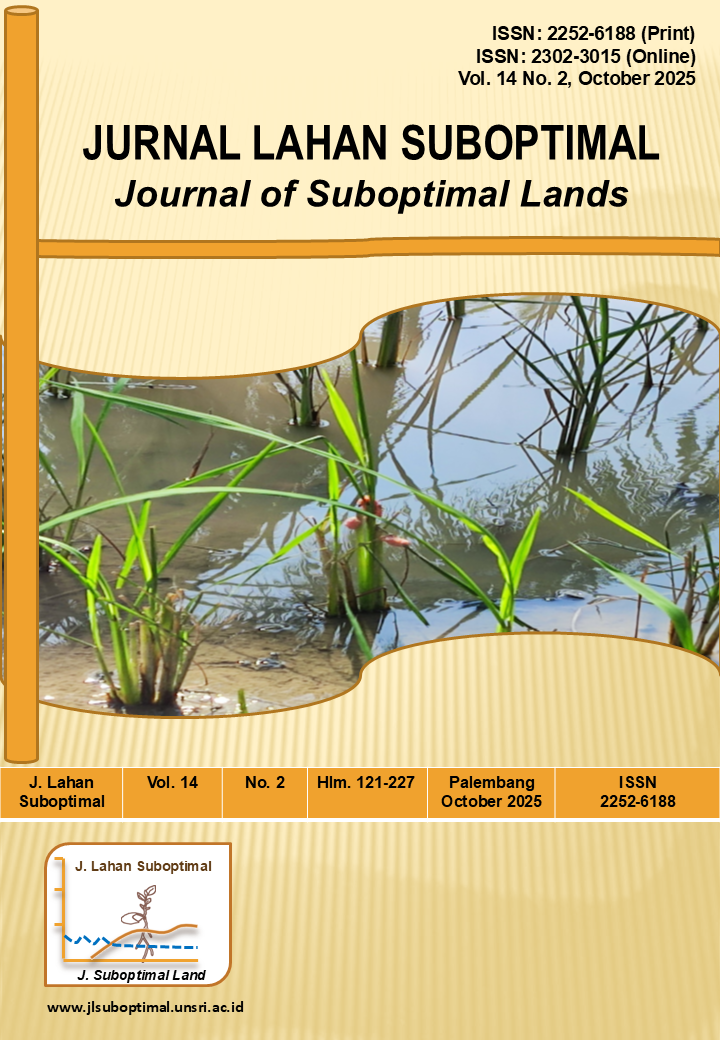Cadmium in the roots and leaves of tea (Camellia sinensis L.) at PTPN 7 Pagar Alam unit, South Sumatra, Indonesia
DOI:
https://doi.org/10.36706/jlso.14.2.2025.739Keywords:
accumulation, andisols, cadmium, fertilizer, teaAbstract
The excessive and intensive application of chemical fertilizers can increase the concentration of heavy metals in the soil. This study aimed to determine Cd deposition in tea roots and leaves using the Detailed Survey method, with sampling points determined using the stratified sampling method, which involves dividing the samples into several age ranges for the plants. The average concentration of Cd in the roots was 0.015 ± 0.004 mg/kg, while in the tea leaves it was 0.010 ± 0.003 mg/kg. The absorption of Cd in tea plant leaves shows the lowest average absorption rate in samples aged 15–25 years, particularly in plants that were 1 year old after production pruning, at 0.005 mg per plant. However, its content remains well below the maximum threshold of cadmium in tea, which was set at 1.0 mg/kg. The age of the plants does not substantially affect the accumulation of Cd in tea leaves; however, tea pruning does affect the accumulation of Cd in the leaves. The research findings indicate that the concentration of Cd in the roots and leaves of tea plants was very low, far below the established Cd threshold, influenced by regular pruning, which results in minimal Cd absorption in the tea leaves. Leaves were considered safe for consumption by humans and animals. Data on the levels of Cd in tea roots and leaves are still rarely found, so it was recommended to further investigate Cd in tea roots and leaves.
References
Abd Elnabi, M. K., Elkaliny, N. E., Elyazied, M. M., Azab, S. H., Elkhalifa, S. A., Elmasry, S., Mouhamed, M. S., Shalamesh, E. M., Alhorieny, N. A., Abd Elaty, A. E., Elgendy, I. M., Etman, A. E., Saad, K. E., Tsigkou, K., Ali, S. S., Kornaros, M., & Mahmoud, Y. A. G. (2023). Toxicity of heavy metals and recent advances in their removal: a review. Toxics, 11(7), 1–29. https://doi.org/10.3390/toxics11070580
Alam, M., Hussain, Z., Khan, A., Khan, M. A., Rab, A., Asif, M., Shah, M. A., & Muhammad, A. (2020). The effects of organic amendments on heavy metals bioavailability in mine impacted soil and associated human health risk. Scientia Horticulturae, 262, 1–12. https://doi.org/10.1016/j.scienta.2019.109067
Anda, M., & Dahlgren, R. A. (2020). Long-term response of tropical Andisol properties to conversion from rainforest to agriculture. Catena, 194(May), 1–12. https://doi.org/10.1016/j.catena.2020.104679
Barlog, P., Grzebisz, W., & Łukowiak, R. (2022). Fertilizers and fertilization strategies mitigating soil factors constraining efficiency of nitrogen in plant production. Plants, 11(14), 1–35. https://doi.org/10.3390/plants11141855
Bhat, S. A., Bashir, O., Ul Haq, S. A., Amin, T., Rafiq, A., Ali, M., Américo-Pinheiro, J. H. P., & Sher, F. (2022). Phytoremediation of heavy metals in soil and water: An eco-friendly, sustainable and multidisciplinary approach. Chemosphere, 303(April), 1–10. https://doi.org/10.1016/j.chemosphere.2022.134788
Bielczynski, L. W., Mateusz, K. Ł., Hoefnagels, I., Gambin, A., & Croce, R. (2017). Leaf and plant age affects photosynthetic performance and photoprotective capacity 1. 175(December), 1634–1648. https://doi.org/10.1104/pp.17.00904
Bracher, C., Frossard, E., Bigalke, M., Imseng, M., Mayer, J., & Wiggenhauser, M. (2021). Tracing the fate of phosphorus fertilizer derived cadmium in soil-fertilizer-wheat systems using enriched stable isotope labeling. Environmental Pollution, 287, 1–10. https://doi.org/10.1016/j.envpol.2021.117314
Briat, J., Gojon, A., Plassard, C., & Rouached, H. (2020). Reappraisal of the central role of soil nutrient availability in nutrient management in light of recent advances in plant nutrition at crop and molecular levels. European Journal of Agromomy, 116, 1–13. https://doi.org/10.1016/j.eja.2020.126069
Chaudhuri, S., Das, G., & Narasayya, V. (2007). Optimized stratified sampling for approximate query processing. ACM Transactions on Database Systems, 32(2), 1–58. https://doi.org/10.1145/1242524.1242526
Estiarte, M., & Peñuelas, J. (2015). Alteration of the phenology of leaf senescence and fall in winter deciduous species by climate change: Efects on nutrient proficiency. Global Change Biology, 21(3), 1005–1017. https://doi.org/10.1111/gcb.12804
Fei, X., Lou, Z., Xiao, R., Ren, Z., & Lv, X. (2020). Contamination assessment and source apportionment of heavy metals in agricultural soil through the synthesis of PMF and GeogDetector models. Science of the Total Environment, 747(198), 1–12. https://doi.org/10.1016/j.scitotenv.2020.141293
Genchi, G., S, S., Graziantono, L., Carocci, A., & Catalano, A. (2020). The effects of toxicity. International Journal of Environmental Research and Public Health, 17(Cd), 1–24.
Ginting, R., Mukhlis, S., & Sitanggang, G. (2015). Survey and Mapping of P Nutrient Status in Kabanjahe Sub-District, Karo Regency Jurnal Online Agroekoteknologi, 3(3), 1226–1232.
Guo, Z., Gao, Y., Yuan, X., Yuan, M., Huang, L., Wang, S., Liu, C., & Duan, C. (2023). Effects of heavy metals on stomata in plants: a review. International Journal of Molecular Sciences, 24(11), 1–22. https://doi.org/10.3390/ijms24119302
Hidayati, N. (2005). Phytoremediation and the Potential of Hyperaccumulator Plants. HAYATI Journal of Biosciences, 12(1), 35–40. https://doi.org/10.1016/S1978-3019(16)30321-7
Irawati, T., & Widodo, S. (2017). The influence of seedling age and harvesting age on the growth and production of hydroponic NFT lettuce (Lactuca Sativa L.) grand rapids variety. Jurnal Hijau Cendikia, 2, 21–26.
Johri, N., Jacquillet, G., & Unwin, R. (2010). Heavy metal poisoning: The effects of cadmium on the kidney. BioMetals, 23(5), 783–792. https://doi.org/10.1007/s10534-010-9328-y
Kiran, Bharti, R., & Sharma, R. (2021). Effect of heavy metals: An overview. Materials Today: Proceedings, 51(July), 880–885. https://doi.org/10.1016/j.matpr.2021.06.278
Lin, H., Wang, Z., Liu, C., & Dong, Y. (2022). Technologies for removing heavy metal from contaminated soils on farmland: A review. Chemosphere, 305(May), 135–157. https://doi.org/10.1016/j.chemosphere.2022.135457
Naser, Mohammad, Habib Sultana, S., Mahmmud, N. U., Rebeca Gomes, & Noor, S. (2011). Heavy metal levels in vegetables with growth stage. Bangladesh J. Agril. Res., 36(December), 563–574.
Natsir, N. A., Hanike, Y., Rijal, M., & Bachtiar, S. (2019). Heavy metal content of lead (Pb) and cadmium (Cd) in water, sediment, and mangrove organs in Tulehu Waters. Biosel: Biology Science and Education, 8(2), 149–159. https://doi.org.10.33477/bs.v8i2.1144
Naumann, M., Koch, M., Thiel, H., & Gransee, A. (2020). The importance of nutrient management for potato production part ii : plant nutrition and tuber quality. European Potato Journal, 63(1), 121–137. https://doi.org.10.1007/s11540-019-09430-3
Pasricha, S., Mathur, V., Garg, A., Lenka, S., Verma, K., & Agarwal, S. (2021). Molecular mechanisms underlying heavy metal uptake, translocation and tolerance in hyperaccumulators-an analysis: Heavy metal tolerance in hyperaccumulators. Environmental Challenges, 4(June), 1–17. https://doi.org/10.1016/j.envc.2021.100197
Raza, A., Habib, M., Kakavand, S. N., Zahid, Z., Zahra, N., Sharif, R., & Hasanuzzaman, M. (2020). Phytoremediation of cadmium: Physiological, biochemical, and molecular mechanisms. Biology, 9(7), 1–46. https://doi.org/10.3390/biology9070177
Sabet, A. P., Cheraghi, M., Lorestani, B., Sobhanardakani, S., & Merrikhpour, H. (2020). Analysis, spatial distribution and ecological risk assessment of arsenic and some heavy metals of agricultural soils, case study: South of Iran. Journal of Environmental Health Science and Engineering, 18(2), 665–676. https://doi.org/10.1007/s40201-020-00492-x
Sari, K., & Sulistiani, W. S. (2017). Plant Physiological responses to heavy metal-contaminated environmental conditions: will they lose or survive? In Proceedings of the National Education Seminar, (pp. 478–483).
Shahid, M., Dumat, C., Khalid, S., Schreck, E., Xiong, T., & Niazi, N. K. (2017). Foliar heavy metal uptake, toxicity and detoxification in plants: A comparison of foliar and root metal uptake. Journal of Hazardous Materials, 325, 36–58. https://doi.org/10.1016/j.jhazmat.2016.11.063
Siringoringo, V. T., Pringgenies, D., & Ambariyanto, A. (2022). Study on the heavy metal content of mercury (Hg), copper (Cu), and lead (Pb) in Perna viridis in Semarang City. Journal of Marine Research, 11(3), 539–546. https://doi.org/10.14710/jmr.v11i3.33864
Tan, X., Huang, J., Lin, L., & Tang, Q. (2022). Exogenous melatonin attenuates cd toxicity in tea (Camellia sinensis). Agronomy, 12(10), 24–85. https://doi.org/10.3390/agronomy12102485
Tani, M., Kinoshita, R., Aiuchi, D., & Palta, J. P. (2023). Cadmium in soils and potato tubers under grower management in two contrasting soil types of Hokkaido, Japan. Soil Science and Plant Nutrition, 69(1), 1–9. https://doi.org/10.1080/00380768.2022.2137694
Widowati, H., Sari, K., & Sartika Sulistiani, W. (2016). The management of vegetable cultivation to protect the consumer from heavy metal pollution. Scientific Journal of PPI-UKM Science and Engineering, 3(4), 1–12. https://doi.org/10.21752/sjppi-ukm/se/a14092016
Zhang, J., Yang, R., Chen, R., Peng, Y., Wen, X., & Gao, L.
(2018). Accumulation of heavy metals in tea leaves and potential health risk assessment: A case study from Puan County, Guizhou Province, China. International Journal of Environmental Research and Public Health, 15(1), 1–22. https://doi.org/10.3390/ijerph15010133
Downloads
Published
How to Cite
Issue
Section
License
Copyright (c) 2025 Siti Tri Pebriani Daulay, Dedik Budianta

This work is licensed under a Creative Commons Attribution-NonCommercial-ShareAlike 4.0 International License.













